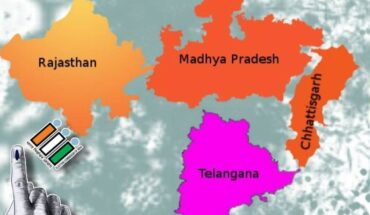
The invisibility and lack of recognition of unpaid domestic and care work result in gender inequality and women’s disempowerment. According to the recent Periodic Labour Force Survey (PLFS), women’s participation in employment in India is low and significantly less than that of their male counterparts. Women comprised just 18 % of the workforce compared to 52 % of men before the pandemic. A Centre for Monitoring Indian Economy (CMIE) survey revealed that around 39 % of women lost their jobs during the ongoing pandemic due to several reasons, including an increasing demand for unpaid domestic work put on them by their families. Globally, while unpaid domestic work by women is valued at nearly 13 % of the total economy, in India, women’s unpaid domestic work is estimated to be valued at almost 40 % of its GDP. While women carry the Indian economy on their backs through their backbreaking domestic work and care work, it often goes unaccounted for as it is not considered productive labour.
This devaluation of women’s work and its exclusion has led to the reinforcement of the gendered division of paid and unpaid labour, leaving women without wages and little bargaining power in the household and allowing the vicious circle to continue where men, economy, and country prosper at their expense.
It is argued that engagement in unpaid domestic and care work is one of the prime reasons for women’s low participation in economic activities. Women do an average of 75 % of the world’s total unpaid care work. Women’s unpaid domestic work is often invisible but has immense value. According to the International Labour Organisation (ILO), a huge 16.4 billion hours are spent by women on unpaid care work daily. This is equivalent to two billion people working eight hours per day, without payment. The actual value of this work amounts to 9% of the global GDP, which is equivalent to $11 trillion.
Similar differences also exist in women’s time allocation to paid and unpaid work by geography. In rural areas, Indian women spend more time in unpaid activities in comparison to urban areas. Women are more likely to spend less time in unpaid work and men are less likely to contribute to housework in northern states over southern states. Haryana is the most unequal among the Indian states with men aged between 15-59 spending just 15 minutes on unpaid housework every day while women of the same age do 269 minutes of unpaid housework. Social norms expect women to perform unpaid labour in India and the consequences for straying from the norm can be harsh. OXFAM India’s 2019 household care survey found that one in three survey respondents thought that it was acceptable to beat a woman for failing to care well for the children or not attending to a dependent or ill adult member in the household .For failing to prepare a meal for the men in the family, 68 % of survey respondents thought women should be harshly criticized and 41.2 % thought they should be beaten .About 66 % of the working women surveyed in Delhi by the Institute of Social Studies Trust ( ISST )reported an increase in household chores and 36 % stated an increased burden of child and elderly care work during the pandemic.
Billions of dollars are spent each year to alleviate material poverty, while time poverty is often ignored or. In this Perspective, we discuss the societal, organisational, institutional and psychological factors that explain why time poverty is often under appreciated. We argue that scientists, policymakers and organisational leaders should devote more attention and resources toward understanding and reducing time poverty to promote psychological and economic well-being. Therefore, the strong message emerging is that policymakers and employers need to act fast to reduce “time poverty” among women and push for greater gender equality in the labour market and an urgent need for gender budgeting.
The story of women in India being overburdened with unpaid work is centuries old. The time use survey conducted by the National Sample Survey Office (NSSO) in 2020-21 confirms a persistent pattern of “time poverty” suffered by women in India. The NSSO survey showed that women spent 84 % of their working hours on unpaid activities, while men spent 80 % of their working hours on paid work. One of the repercussions of their unpaid work burden is their lack of participation in paid work. Indian women’s participation in paid employment is much lower than their male counterparts. Only 21.8 % of women aged 15-59 years were engaged in paid work in comparison to nearly 70.9 % of the men. However, if we were to take into account both paid and unpaid work, women’s participation reaches 85 % men’s is just 73 %.
In 2019, the time spent by Indian women on unpaid work was 10 ten times more than men. TUS 2019 shows that women participation in unpaid domestic services for household members – cooking, cleaning, household management – is as high as 81.2 per cent each day compared with 26.1 % for men. It also states that there is a wide gender disparity, with only 18.4 % women participating in employment activities compared with 57.3 % of men; also, while men spend an average of 459 minutes (7 hours and 39 minutes), women spend only 333 minutes (5 hours and 33 minutes). There is a stark difference in the time spent by men and women in caregiving activities for a dependent child or an adult. While only 14 % of men participate in unpaid caregiving services for household members spending on average 76 minutes a day (1 hour and 16 minutes), the share of women ((2 hours 14 minutes) is almost double at 27.6 %
Unlike in international TUS in India, the reporting of time spent on various activities was not done separately by each person in the household, but often by a central respondent for all members of the household. It is entirely possible that male respondents overstated their contributions to domestic chores and understated their wives’ contributions to economically productive work.
The COVID-19 global crisis has exposed the fact that the world’s economies and our daily lives are made possible by the unpaid care work of women, which is often invisible and under-appreciated. Indian women spend the maximum time in childcare among those surveyed from the other nations. Similarly, several estimates reveal that the pandemic has disproportionately increased women’s “time poverty” by up to 30 % in India.
In India, the 2021 state assembly elections offered a unique and unexpected opportunity for the recognition of women’s UDCW through promises of unconditional cash transfers. However, direct benefit transfers (DBT) are not a magic bullet for achieving women’s economic empowerment. There is a fundamental need to secure an adequate financial infrastructure and financial literacy. Although some of the negative consequences anticipated by the critics of such transfers were not borne out in reality, it was noted that the patriarchal social norms around UDCW are so deeply entrenched that explicit feminist messaging on the part of the government is necessary to shift social norms towards the recognition and eventual reduction and redistribution of UDCW. In short, unconditional cash transfers like the scheme are an innovative means of recognising women’s UDCW which could potentially rewrite the relationship between women and the Indian welfare state and hold critical insights for international debates on the vexed relation between paid work, unpaid work, and social reproduction. LFPR should increase. Females should not be replaced by men rather more employment opportunities should be increased for both to absorb the increasing population.
Dr.Harvinder Kaur, Associate Professor in Economics, Ambala, views are personal.





